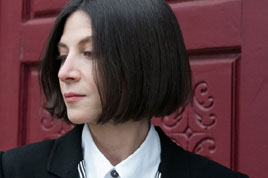EVENT BOOK - Review of Donna Tartt's - The Little Friend
bookmunch - stoop
More than possibly any other title this year, Donna Tartt's The Little Friend is an EVENT BOOK (in the way that, say, Martin Scorcese's forthcoming Gangs of New York is an EVENT MOVIE). It's been ten years since her hugely best-selling debut, The Secret History, ten years filled with rumour (you would not believe half the things Tartt has been credited with in this period) and little else. Given such a hiatus, the volume of expectation that has built up around The Little Friend is perhaps understandable. Expectation, however, can be something of a double-edged sword: yes, you know that the book will sell (unlike music or film, periods of silence only enhance an author's reputation) but the book MUST be good (must be better than good, must be GREAT, must DELIVER THE GOODS in such an unexpected way that all Tartt fans say yes, she has done a good job, yes this is BETTER than The Secret History, this is the best book this year by a country mile . . .). And, well, has she? Is it? Well . . .
You can outline the plot of The Little Friend in just over ten words: twelve year old Harriet Cleves sets out to avenge her brother Robin's murder. But this gives you no idea whatsoever about the book. To all intents and purposes, this narrow outline is a sign placed in your path by Wile E Coyote reading DIVERSION. Yes, there is a murder (Robin Cleves is found hanging from a tree in his back garden, within walking distance of his four year old sister Allison and his baby sister Harriet). Yes, it remains unsolved (never mentioned within Robin's immediate family, subject to wild rumours among the town's folk). Yes, Harriet sets out to avenge the murder (years have passed and Harriet – as different from her vague and beautiful sister Allison as can be imagined – wants her many questions answered). But. That doesn't really help. The first thing you need to know about The Little Friend is this: Harriet's family were once very, very wealthy. Her great-grandfather Judge "Bully" Cleves owned an enormous house called Tribulation, and his daughters, Libby, Adelaide, Tut and Edie were raised in what one might call "comfort". The wealth has now dried up (somewhat). Our protagonists are not poor (not by any means) but you can detect the tang of rotting fruit in their opulence. This Eden is on the turn, and its bitter smell infects all: Harriet's mother Charlotte never got over the death of her son and spends the better part of her time in bed; Harriet's father Dix works in another state, rarely returns home, keeps a mistress; Harriet's sister Allison lacks definition, orbiting the world without direct contact, reflecting her mother's neglect back at her, sleeping all day if she can; Harriet's aunts bicker and squabble, maintaining a youthful world in their conversation with each other, overlooking change and ignoring neglect, allowing newspapers and dirt to build up in Harriet's house without saying a word. People are too busy for Harriet and nobody really listens to anybody else. Little wonder then that Harriet has the freedom to do all that she does. After a brief chat with her mother's maid Ida, and a brief glimpse at contemporary newspaper cuttings from the period of her brother's death, Harriet assigns guilt to the Ratcliff's (in general) and Danny Ratcliff (in particular). The Ratcliffs are a wild, white trash phantasmagoria: you have Danny, first of all, a junked out speed freak, eager to put his past behind him, eager to get away from all of the ***** dealt him by . . . Farish, his older brother (Farish has a milky eye from the time he shot himself in the head trying to get away from the cops, and the bullet in his head eased certain criminal proclivities at the same time as it left him paranoid and just plain weird); next up is Eugene, once criminal, converted in prison to the way of the Lord and now given to preaching on street corners; followed in quick succession by Curtis (Harriet's age, special needs, think Lenny in Of Mice and Men) and Gum (the boy's aged relative, cut through with cancer, dying this last decade). Eschewing the single narrator of The Secret History, The Little Friend inhabits all of these people at some point in the book. This in itself is probably the most significant difference between this book and the last. Harriet assigns blame to Danny and then spends the majority of The Little Friend following the Ratcliffs, spying on them, making notes in her little red notebook, getting in their way, making her presence felt until (given that we're talking about speed-driven amphetamine freaks) the Ratcliffs decide enough is enough.
By which point, of course, enough is indeed enough. What you've got here is Harriet the Spy or Nancy Drew. Essentially. The action of The Little Friend could be the action of virtually any episode of The Red Hand Gang. We're talking about a crime novel here, right? Or we would be talking about a crime novel in any other circumstances. What we have here is a very strange fish indeed. Many reviews of The Little Friend have remarked that, with the exception of one or two slightly more disturbing scenes and a "mother*****er" here and there, this could be a children's book. A children's book in the vein of, say, To Kill a Mockingbird. Certainly these elements exist but that isn't the whole story. The whole story is far more complex. Imagine a famous Impressionist taking on children's TV, such that you could visit the Tate, say, or the Louvre, and see Rembrandt's Tinky-Winky or Monet's Po. No matter how wondrous the art, you couldn't help but think – surely there are grander vistas than this to be realised? The subject matter is overwhelmed by the style in which it is produced. I'll give you an example. Harriet is hiding in a wood spying on Danny Ratcliff: "Airy clouds of gnats swirled away from her, spinning from the sudden movement like pond creatures in green water. In the daylight, the path was narrower and more choked than she had imagined it to be in the dark: barbs of fox-tail and witch-grass prickled up in tufts, and the ruts of the clay were coated in scummy green algae." For pages at a time, the action is neglected in favour of description – reading The Little Friend is like watching broken TV or pirate video (the colour needs adjusting, everything is bright red, people move leaving vapour trails) – it doesn't matter that you can hear what is being said, the context in which those things are said gives you migraine. In addition to which, Harriet (drawn as she is to resemble a miniature Donna Tartt) is frequently far too erudite for her own good (on page 516, for example, she observes a "jaunty Tyrolean hat" and remarks upon a nurse's similarity to Kabuki Theatre). In addition to which, Harriet also enjoys flawless recall (recall similar to that displayed by the characters of The Secret History) – quoting from any number of children's books in a way that I am convinced would not be usual in a 12 year old girl. Similarly, the Ratcliffs are somewhat fuzzy – they are white trash colour-by-numbers.
The Little Friend, then, is somewhat eccentric. The Little Friend is odd. This is a book out of step with the world (if this book was a person, it would be James Stewart in Harvey). Reading The Little Friend is a little like finding yourself holding on to a drain pipe thirty storeys up as the said drain pipe pulls away from the wall (reading The Little Friend is a little like being Harold Lloyd). This is a book that, you feel, has been laboured over and the labour is all too apparent. Each sentence feels like it has been put through the paces. Each word feels like the product of serious gym time. The reek of work, the work that this is, comes off the page like sweat. You want to say: relax. You want to say: don't work so hard. You want to edit and make suggestions (how much more satisfying a book this would be if it was solely from Danny Ratcliff's perspective (a little girl is terrorising him and he doesn't know why – 350 pages, classic)). Still. It is idle to speculate on what this book might have been. We can only work with what we have and, while there is much to like here, one cannot wholly recommend the experience of reading The Little Friend.
Any Cop?: Despite the fact that there is much to like about The Little Friend, the over-riding impression left by this book is one of bewilderment and misapprehension – this is a children's book for adults.
+ + + Comments + + +



